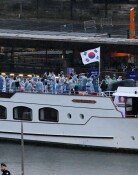Six Decades of Statistics Since National Independence.
Six Decades of Statistics Since National Independence.
Posted August. 13, 2005 03:06,
In 1945 when Korea became independent from the Japanese colonial rule, Seoul citizens paid 16 jeon (one jeon is equivalent to one hundredth of one won in value) for a streetcar trip. Now, 60 years from then, people pay 800 won for a bus ride with a commuter card.
If you do simple math, the fare has risen 5,000 times. But given that the government pushed for two currency reforms in 1953 and 1962 (100 won → one hwan, 10 hwan → one won), the actual fare has surged as much as five million times.
60 Years of Statistics Since National Independence, which was released by the Bank of Korea on August 12, contains many interesting statistics.
Consumer prices have skyrocketed 110,000 times in 60 years at an average annualized rate of 21.3 percent since the nation became independent.
It is no exaggeration to say that prices rose nearly everyday for the first 20 years (1945-1965). For the period, consumer prices have risen at an average of 51.1 percent annually as the nation kept issuing money to finance the war and step up economic development. All in all, consumer prices rose 3,864 times in 20 years.
Consumer price growth has stabilized gradually from 12.9 percent for the period between 1966 and 1985 to 4.7 percent between 1986 and 2005. But the sharp rise in prices for the first 20 years has imposed tremendous pressure on the economy.
The price of the dried walleye pollack has recorded the highest growth among basic necessities. The price of the fish has surged 6,225 times from 80 jeon in 1945 to 4,980 won. Given that the value of currency has dropped due to the currency reform, its price has risen 6,225,000 times.
One official from the Bank of Korea said, There is a view that a huge demand for the fish coupled with the limited supply has driven up the price significantly. Koreans drink a lot for the past turbulent 60 years and the fish is known as a good ingredient for hangover soup.
Other products price growth has outstripped average consumer price growth for the same period. Beef (500g) prices have risen 1.92 million times, and the Seoul-Busan train charge (first class) and rice prices (80kg) have surged 550,000 times. The price of cigarettes (one pack of the highest class product) has risen 500,000 times.
The nations economy has also shown stunning growth.
Nominal GDP has expanded 520 times from $1.3 billion in 1953, when the Bank of Korea began compiling the statistics, to $680.1 billion last year.
Per capita GNI has also grown 211 times from $67 to $14,162 for the same period.
The average monthly wage in manufacturing industry has surged 1,141 times from 2,030 won in 1957 to 2,316,607 won in the first quarter (January-March) this year.
The per capita tax burden has also grown 3,783 times from 684.3 won in 1957 to 2,588,437 won (based on the budget) this year, indicating that Koreans are now under a much higher tax burden.
Kyung-Joon Chung news91@donga.com







